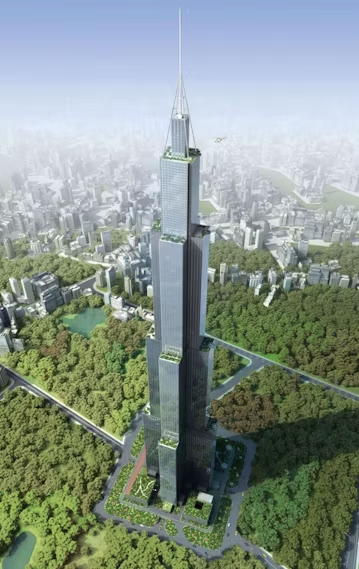If you needed further evidence that the world of architectural design is transforming fast, look no further than Marc Kushner’s new book The Future of Architecture in 100 Buildings, released this week in conjunction with the architect’s uplifting TED Talk. When establishing just howfast, though, one particular question that Marc poses stands out amongst the rest:
Can a skyscraper be built in a day?
The hyperbolic premise may seem farfetched in the extreme — but one company in China is attempting to change our preconceptions about the limitations of prefabricated architecture. Broad Group’s Broad Sustainable Building division (BSB) is out to challenge the notion that quality must be compromised in the name of speed, developing high performance building components that surpass the energy efficiency of many standard spec models — and assembling them at a staggering pace.

BSB’s latest incarnation, in all its time-lapsed GIF glory. Via Sploid
As news of their latest, tallest skyscraper makes waves across the online world, we’re taking the opportunity to look at the past, present and future potential of this firm’s truly time-bending building techniques. Strap yourself in, it’s going to be a lightning-fast ride…
2010: 6 Stories, 1 Day
BSB first hit the headlines when they used their pioneering modular system to construct a 6-story pavilion for the Shanghai World Expo. The steel frame was developed with integrated diagonal bracing to withstand earthquakes up to level nine on the Richter scale, and with 15cm insulation and triple glazing, the firm signaled their intention to prioritize energy efficiency as well as construction speed.
2010: 15 Stories, 6 Days
Later that same year, BSB utilized the same techniques to construct the Ark Hotel in eastern China in a little under a week. Air conditioning, electricity, and plumbing components are built into the floor panels of each level, while cladding panels and dry-walling is pre-manufactured in factories with minimal construction waste.
2012: 30 Stories, 15 Days
On the shore of Dongting Lake in the Hunan Province of China, BSB built another hotel, the T30, at a seemingly leisurely rate of 2 stories a day. This isn’t just any old hotel: It is a 5-star, 350-room destination, with the requisite restaurant, bar, gym, top-floor swimming pool, underground parking… and a helipad, naturally. The building also boasts quadruple glazing, LED lighting, and water-efficient toilets.
2015: 57 stories, 19 days
Having developed their rapid building technology further still, BSB returned this year with a 57-story building, assembled at a rate of three stories a day. The video illustrates that the design of the steel frame has been refined to reduce the number of prefabricated components, and the quadruple glazing bears aesthetic similarities to Rafael Viñoly’s 10-foot square windows in the super-slim 432 Park Avenue condominium currently on the rise in New York.
The Future: 220 stories, 90 days
BSB has had grander plans on the drawing board for a while now: As far back as 2012, it declared its intentions to build the “Sky City One,” a 220-story, 838-meter tall skyscraper in Changsha, south-central China. Including the time necessary for prefabrication of all elements, the total construction time is estimated at 210 days.
The Sky City project has not yet taken off as intended due to a delay in government approval, but the principles have been proven by the firm’s increasingly lofty prototypes. In fact, BSB’s ambitions don’t stop there: CEO Zhang Yue believes that the same techniques of prefabrication and assembly can be used to construct a 636-floor mega-tall skyscraper, its summit soaring two kilometers above the ground.

A rendering of the proposed Sky City One. Via chinadefence.com
It may sound outlandish, but Zhang sees it as a logical projection of the environmentally sound modular design his firm has already developed. When asked what the odds were of such a gargantuan structure coming to fruition he replied with gusto:
“One hundred percent! Some say that it’s sensationalism to construct such a tall building. That’s not so. Land shortages are already a grave problem. There’s also the very serious transportation issue. We must bring cities together and stretch for the sky in order to save cities and save the Earth. We must eliminate most traffic, traffic that has no value! And we must reduce our dependency on roads and transportation.”
Motivational speakers often tell us to “reach for the sky,” but it appears that BSB is aiming much higher than that. Keep an eye on China for fast-paced developments in the near future…
Yours speedily,









